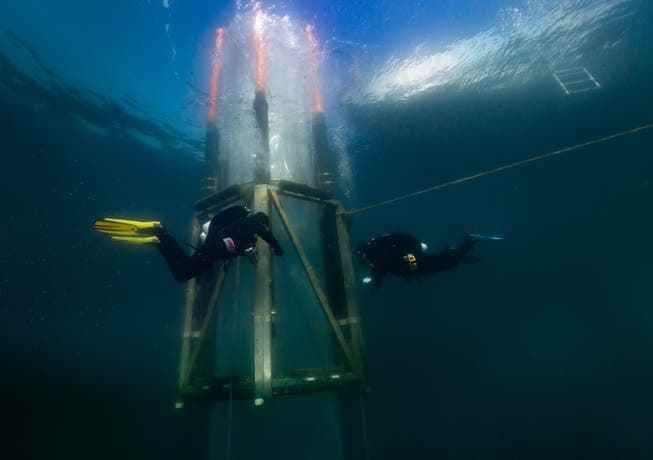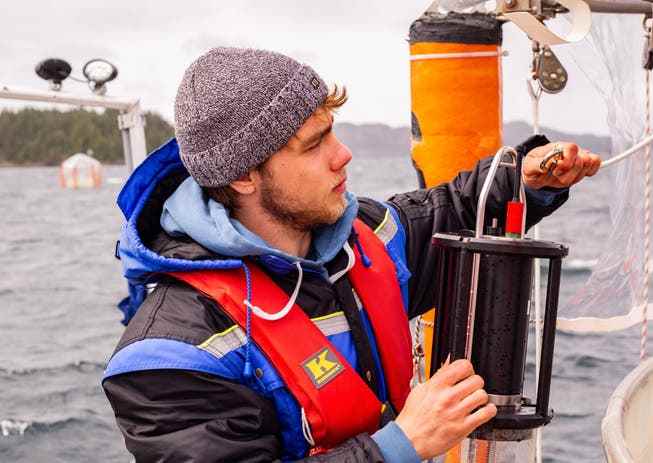Just CO2-Reducing emissions will not stop global warming. That’s why researchers are working on transporting the greenhouse gas into the world’s largest storage facility – the ocean.
The laboratory vessels with which researchers are investigating how the sea increases CO are floating off the Norwegian coast2-Intake can be stimulated.
These test tubes don’t fit into any laboratory. With a length of 20 meters and a diameter of a good 2 meters, they float upright in the Raunefjord south of Bergen. The boom of a research ship heaves the transparent containers one after the other into the North Sea. Divers flood them with seawater and seal them along with algae, plankton and microorganisms.
Only the dome-shaped hatches of these underwater laboratories protrude from the waves. Researchers tip in finely ground rock from inflatable boats. The mineral powder neutralizes the carbonic acid in the sea water. As a result, this more CO2 absorb from the air.
Professor Ulf Riebesell from the Geomar Helmholtz Center for Ocean Research Kiel and his team use the underwater laboratories in a real environment to test how much CO2 can be stored in seawater and how this affects the underwater fauna.
The oceans are huge CO even without intervention like this2-Storage: According to the current “Global Carbon Budget” study they can absorb around a third of the 36 billion tons of CO that are produced each year2 record, tape. Earlier studies had assumed only a quarter. It is estimated that the bound CO2 stay in the oceans. Because CO2 reacts with water to produce weak carbonic acid, but acidifies the oceans in the process. This inhibits calcareous organisms such as plankton, snails and mussels.
Rock flour reverses ocean acidification
There are several methods that the CO2-Can increase uptake from the oceans while halting acidification. Riebesell’s team is investigating one of the most promising in the large tanks off Bergen: the “alkalinization” of the seas.
This method uses mineral flour such as slaked lime, which is obtained from carbonate rock such as limestone. The lime dissolves in the water. In the process, hydroxide ions are released. These charged particles bind the CO dissolved in the water2. This creates the ion hydrogen carbonate, in which the CO2 is imprisoned. The whole thing is a normal weathering process.
The process is not visible to the naked eye, nor is the subsequent gas exchange: the trapped CO is now missing2 in seawater, and new CO2 moves from the atmosphere into the sea. Riebesell explains that one to two kilograms of rock flour are needed to produce one kilogram of CO in this way2 to bind. A positive side effect of the alkalinization: some of the hydroxide ions neutralize the CO2-related ocean acidification.
The resulting hydrogen carbonate ion is used by calcareous organisms such as snails and mussels to build up their calcareous shells. However, an oversupply can mean that they grow much faster and the ecological balance is disturbed.
“Marine geoengineering”, which also includes alkalinization, has been criticized by environmental organizations because the effects are still unclear. The process is also less popular with the general public than biological methods for removing CO2 to save, such as the reforestation of algae forests.
“The alkalinization is only an acceleration of natural weathering,” says the oceanographer Riebesell. It is not only more effective, but also sometimes associated with fewer side effects than biological methods. “We will examine the risks closely, but we also have to weigh them against the risks that will follow if we do nothing,” he says. Simply by reducing greenhouse gases, without the additional removal of CO2 from the atmosphere, the 1.5 degree climate target can no longer be achieved. For Riebesell, doing nothing is therefore not an option.
Not all rock flour works equally well
In the search for the rock powder that works best, his team found what they were looking for: slaked lime and olivine caught CO2 most effective one. The researchers poured different concentrations of the substances into the oversized test tubes. For eight weeks, they drove to the containers every day and took water samples.
They then examined the calcifying organisms living in it, such as pteropods and calcareous algae. To their surprise, the calcifiers had not taken advantage of the oversupply of bicarbonate. The organisms in the alkalinized test tubes had not increased in number or changed compared to their untreated neighbors. “We can now give the all-clear, at least when it comes to alkalinization with slaked lime,” says Riebesell.
The situation was different when olivine was added. The green mineral contains silicon salts, which diatoms need to build their shells. As a result, the algae in the containers really flourished, and the oversupply increased their growth significantly. “From a chemical point of view, both rock flours work well for storing CO2 in the ocean – but olivine has an effect on the ecosystem that slaked lime does not have,” notes Riebesell. The experiment off Bergen has been completed, but the analysis of the research data is still ongoing.

Research divers at the mesocosm at the level of the buoyancy bodies in which the mesocosm bags are suspended.
Nickel, iron and silicon can change the ecosystem
His findings also confirmed a study by the University of Tasmania and Oxford University. Calcium and magnesium-based rock flour does not change the diversity of marine fauna. However, if the rock flour contains nickel, iron or silicon, side effects on the marine ecosystem are possible, according to the authors. The study does not see this as a knockout criterion, but only points out that the effect and efficiency of the rock powder must be thoroughly investigated before it can be used worldwide.
First author of the study is biogeochemist Lennart Bach from the University of Tasmania. He discovered another downside of olivine: in one experiment, he ground the green mineral and dissolved the powder in seawater in the lab. In the first few hours there was rapid alkalinization, but then the effect wore off. One of the reasons for this was that a calcareous protective layer formed on the olivine powder, which prevented further reaction.
Burnt lime is better suited because it dissolves faster in water and reacts more strongly, says Bach. Quicklime is unslaked lime – and from a chemical point of view it is calcium oxide. However, its production consumes a lot of energy. Bach therefore advocates obtaining it from industrial waste. Slag, which is used in the production of steel, is suitable for this. The lava-like rock mass is disposed of as waste in huge heaps. After it has cooled, it can be ground back into a powder that still contains enough quicklime for alkalinization, says Bach.

Sampling with a water sampler on an underwater laboratory tank.
Ships are supposed to bring out the rock dust
For the sake of simplicity, experiments like that of Ulf Riebesell test the alkalinization near the coast. However, the best way to spread the rock powder over a large area is by ship. Sea locations with high wind speeds and strong waves are particularly suitable. There goes a lot of CO2 from the atmosphere into the sea water.
The distribution could be done by companies that use the CO2-Commercialize storage in the ocean. Payment would be based on the amount of greenhouse gas removed. Measuring this amount is difficult, says Riebesell. Because in the ocean there are many factors that influence the success of alkalinization. “If the rock flour is pushed into the sea depths by currents, it has no effect there,” says the oceanographer.
Before it can be used on a large scale, legal approvals are required. Riebesell should not have experimented with rock flour in German waters. Because Germany is the only country in the world that has banned marine geoengineering by national law. “We hope that at least research on this will soon be approved,” says Riebesell, “because we must have these measures in place by 2030.”

